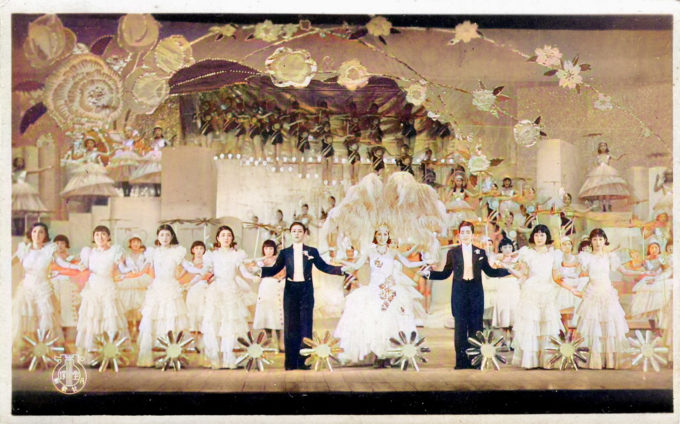
The Takarazuka Revue, c. 1940. (Colorized) Regardless of the era of the musical presented, period accuracy is relaxed for costumes during the Revue’s extravagant finales which include scores of glittering performers parading down an enormous stage-wide staircase and a Rockette-style kick line. Lead performers portraying both male and female roles appear in the finale wearing huge circular feathered back-pieces reminiscent of Las Vegas or Paris costuming.
See also:
Takarazuka Revue, “Parisette”, c. 1930.
Ernie Pyle Theater, Yurakucho, c. 1950
Takarazuka Hotel, Baths and Opera House, Takarazuka, c. 1920-1930
“The Takarazuka Revue Company was founded in 1914 by a new railroad line which had commenced operations just three years earlier.
“Takarazuka, one of the terminal points of the line, had at one time been a spa town, but by the beginning of the [20th century] the spa had fallen into disuse. Thus the theatrical company was established as an attempt to increase ridership on the trains.
“Kobayashi Ichizo, the railroad entrepreneur, had a friend who used a chorus of boys to attract customers to his dry goods store. Perhaps, reasoned Kobayashi, something like this would work for his railroad enterprise. So he assembled a chorus of twenty young girls – ranging in age from twelve to fifteen – and set about organizing a training program for them. Kobayashi and the faculty agreed that eventually this company should present operas.
“They called their company the Takarazuka Girls Opera Company (Takarazuka Shojo Kageki Dan) and, instead of having only the singing and instrumental chorus, decided to present fairy tales in operetta form. This strategy proved very popular and their reputation spread quickly. Within a few years they were performing in Tokyo and in several other cities on their way home from the capital.
“Ten years after its founding, Kobayashi built an immense theatre seating three thousand. Three years later the French revue was introduced into Japan by Takarazuka, and this established the path the company would follow.”
– “The Takarazuka Touch”, by Zeke Berlin, Asian Theatre Journal, Spring 1991
“From the mid-1930s onward the expression danso no reijin, literally ‘a beautiful person [i.e. female] in masculine attire,’ was used sympathetically in reference to both Takarazuka otokoyaku and masculinized females. The expression, a euphemism for chusei, was apparently coined in 1932 by novelist Muramatsu Shofu. His serialized short story, Danso no reijin, was inspired by Kawashima Yoshiko (1906-1948), who donned a military uniform and passed as a man during the early stages of Japanese imperialism in China and Manchuria.”
– Takarazuka: Sexual Politics and Popular Culture in Modern Japan, Jennifer Ellen Robertson, 1998
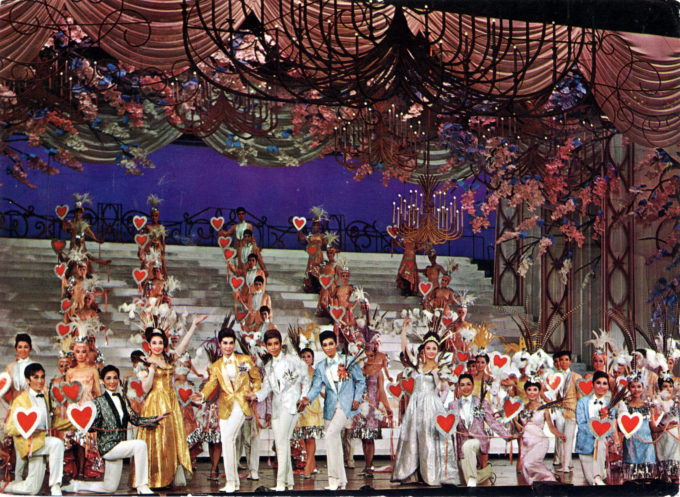
Takarazuka Revue, 1970, the famous all-female musical theater troupe. Women play all roles in lavish, Broadway-style productions of Western-style musicals, and sometimes stories adapted from shōjo manga and Japanese folktales.
- Postcard advertisement for Takarazuka “Morinaga Chocolate Promenade Show”, c. 1937.
- A ¥2 ticket to the Tokyo Takarazuka theater performance on July 17, 1937.
“Part of the novelty of Takarazuka is that all the parts are played by women, based on the original model of Kabuki before 1629 when women were banned from the theater in Japan. The women who play male parts are referred to as otokoyaku (literally ‘male role’) and those who play female parts are called musumeyaku (literally ‘daughter’s role’). The costumes, set designs and lighting are lavish, the performances melodramatic. Side pathways extend the already wide proscenium, accommodating elaborate processions and choreography.
“Before becoming a member of the troupe, a young woman must train for two years in the Takarazuka Music School, one of the most competitive of its kind in the world. Each year, thousands from all over Japan audition. The 40 to 50 who are accepted are trained in music, dance, and acting, and are given seven-year contracts. The school is famous for its strict discipline and its custom of having first-year students clean the premises each morning.
“The Takarazuka Theater was requisitioned during the Occupation Era (1945-1952) for use as a theater for Allied troops, for stage shows and movies. and renamed the Ernie Pyle Theater.”
– Wikipedia


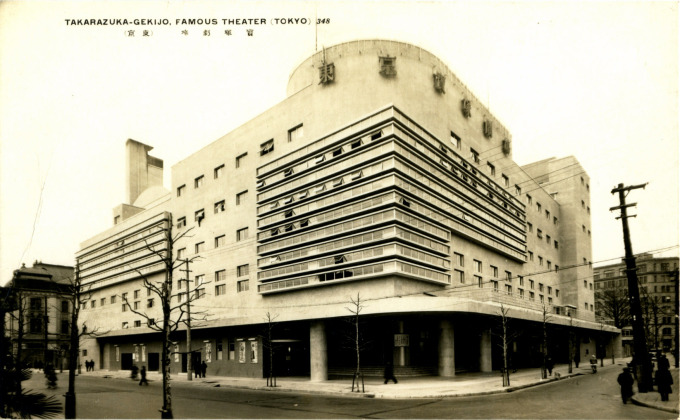
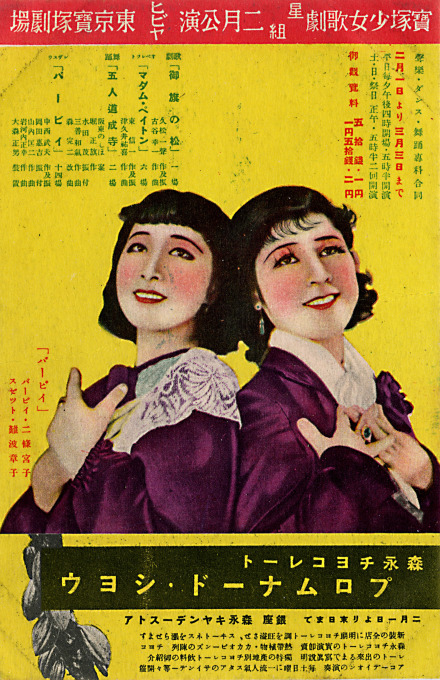

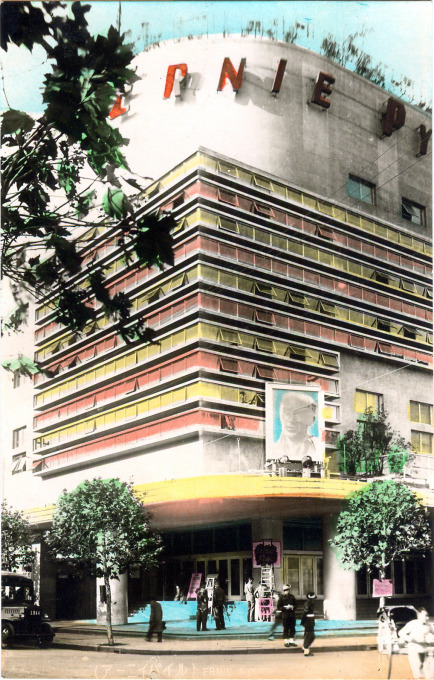
Pingback: Shirokiya Department Store | Old Tokyo
Pingback: Ernie Pyle Theater, Yurakucho, Tokyo, c. 1950. | Old Tokyo
Pingback: Nippon Theater (Nichigeki) | Old Tokyo
Pingback: Aerial View of Yurakucho, c. 1935. | Old Tokyo
Pingback: Takarazuka Hotel, Takarazuka Baths & the Takarazuka Opera House, Takarazuka, c. 1920-1930. | Old Tokyo
Pingback: Kokusai Theater, Asakusa, c. 1940. | Old Tokyo
Pingback: Takarazuka Revue, "Parisette", c. 1930. | Old Tokyo
Pingback: Hayao Miyazaki’s 'Spirited Away' continues to delight fans and inspire animators 20 years after its US premiere ⋆ The EU Times
Pingback: Hayao Miyazaki’s ‘Spirited Away’ continues to delight fans and inspire animators 20 years after its US premiere - Insite Media
Pingback: Hayao Miyazaki’s 'Spirited Away' continues to delight fans and inspire animators 20 years after its US premiere - Inergency
Pingback: Hayao Miyazaki’s ‘Spirited Away’ continues to delight fans and inspire animators 20 years after its US premiere - Wausau Pilot & Review
Pingback: “Princess Turandot”, Takarazuka Revue advertising postcard, Tokyo, 1934. | Old TokyoOld Tokyo
Pingback: Hayao Myazaki's Spirited Away continues to delight fans and inspire animators 20 years after its U.S. premiere - Pancouver
Pingback: Nakahara Jun’ichi fashion illustrations, c. 1945-1948. | Old TokyoOld Tokyo